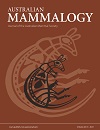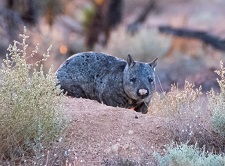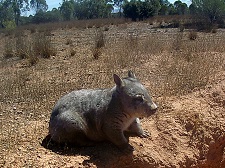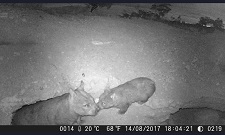
Australian Mammalogy
Volume 43 Number 1 2021
Wombats Through Time and Space
Wombats have a highly adapted digestive system able to process low-quality food, hence do not require high energy foods. All three species feed predominately on native grasses, however the nutritional requirements of wombats varying in age is largely undocumented. Further data regarding the nutritional requirements of juvenile wombats and lactating females, as well as the threshold of water content in food is required. A greater understanding of how drought and changing conditions in their habitats will affect their ability to access nutritionally suitable foods would be advantageous.
The northern hairy-nosed wombat is one of the most endangered marsupials in Australia, with only two wild populations. We reviewed research on this species published during 1980–2019 to assess where information is currently lacking and to inform where future research could be focussed to aid conservation efforts. We found that aspects of the species’ ecology, especially the breeding ecology, remain largely understudied. Further, we consider ongoing conservation threats and highlight the importance – and logistical complexities – of establishing additional populations.
AM20012Genetic monitoring of southern hairy-nosed wombats over two decades reveals that individuals can live for at least 18 years in the same warrens

Rarely are individuals of long-lived species in wild populations tracked over decades. We used hair-trapping techniques together with genetic fingerprinting to follow southern hairy-nosed wombats over an 18 year period, and found that some individuals detected initially were still alive and that they used the same burrow systems (called warrens). Lack of movement over this timeframe highlights the vulnerability of this iconic species to a warming climate. Photograph by Faith Walker.
AM20012 Abstract | AM20012 Full Text | AM20012PDF (383 KB) | AM20012Supplementary Material (247 KB) Open Access Article
AM20005Humerus midshaft histology in a modern and fossil wombat
The common wombat has unique biological and behavioural adaptations that support growth and life in the burrow. Using bone histology, we preliminarily investigated how these adaptations impact the development and microstructure of the wombat forelimb. Comparing modern and fossil bones of Vombatus, we suggest that wombats may have bone microstructural features that reflect lifestyle and growth in the burrow. Future research should test these results on more samples to improve reconstructions of wombat behaviour in the fossil record.
We conducted the first species-wide survey of the southern hairy-nosed wombat (Lasiorhinus latifrons) population. Wombats can be found from Caiguna in Western Australia to the Murray River in South Australia, in five fragmented population groups – Nullarbor Plain, Gawler Ranges, Eyre and Yorke Peninsula and Murraylands regions. The wombat population appears to be undergoing a long term increase in both distribution and abundance, although there are spatial and temporal factors which modify these changes at the local and regional levels.

The distribution and abundance of the southern hairy-nosed wombat are highly patchy, with large clusters of warrens in some areas but few to none in adjacent areas. In order to understand why this occurs, we mapped the species’ distribution and correlated the locations with environmental and landscape data. Overall, the wombat distribution is influenced by rainfall, soil clay content, vegetation type, and, primarily, anthropogenic land-use practices. Photograph by M. Swinbourne.
Zoological parks and wildlife carers were surveyed about current feeding regimes and nutritionally related health condition of their wombats. Current diets of wombats held in captivity are often high in simple carbohydrates and exceeding reported maintenance energy requirements.
AM20030Demographic trends and reproductive patterns in the northern hairy-nosed wombat (Lasiorhinus krefftii) at Epping Forest National Park (Scientific), central Queensland
The critically endangered northern hairy-nosed wombat (Lasiorhinus krefftii) exists at two locations in Queensland. Since 1974, the main population at Epping Forest National Park (Scientific) has been monitored using burrow activity indices, trap-based surveys, remote collection of hair and passive infrared cameras. Here, we summarise demographic and reproductive data to present new population estimates and characterise reproductive patterns for L. krefftii at Epping Forest NP. We find an ongoing increase in population size, supported by healthy levels of reproduction.
AM20001Incidence of sarcoptic mange in bare-nosed wombats (Vombatus ursinus)
 , Jack Wolfenden, Eden M. Hermsen, Blaire T. Vallin, Nicole E. Hunter and Julie M. Old
, Jack Wolfenden, Eden M. Hermsen, Blaire T. Vallin, Nicole E. Hunter and Julie M. Old
Sarcoptic mange is a significant threat to wombats and results in death if left untreated. We estimated the prevalence of sarcoptic mange at three study sites using non-invasive techniques. Prevalence correlated with weather conditions (particularly with yearly rainfall, with a higher incidence of sarcoptic mange occurring in higher-rainfall years), as well as with macropod abundance in the study areas. Prevalence ranged between 7.0% and 40.7%, depending on site, season and year.
AM20044The behaviour and social development of young southern hairy-nosed wombats (Lasiorhinus latifrons)

We used direct observations of a young southern hairy-nosed wombat and video recordings from camera traps to show that young wombats that are still with their mothers have an extensive ethogram that includes autonomous and social play, and precocial aggressive and defensive behaviours. The young wombat associated with its mother for five months, after which time it became independent of her when she moved from the natal warren. Only two of nine young wombats from three warrens were still present there 15 months after the start of the study, suggesting that many young wombats disperse.
AM20021Square salads: exploring the diet of the southern hairy-nosed wombat (Lasiorhinus latifrons) via DNA metabarcoding
Determining the diet of southern hairy-nosed wombats is difficult because they are nocturnal and live underground, yet is important to understand because they are of conservation concern due to anthropogenic climate change and resource depletion. A recent genetic technique called DNA metabarcoding enables diet detection from faeces. We identified the diet of southern hairy-nosed wombats and western grey kangaroos from their faeces to understand what plants they consumed and whether the diets of the two marsupials overlapped. We found that wombats ate large proportions of introduced plants including toxic species and also had a high degree of overlap with western grey kangaroos. These findings suggest that wombats face additional, yet hitherto hidden, challenges.
There is an increasing need to develop management strategies that meet the needs of humans and wildlife. A variety of conflict mitigation measures are available, but for many conflict species like the southern hairy-nosed wombat (Lasiorhinus latifrons) their effectiveness has not been scientifically tested. Deterrents could provide a cost effective and efficient means of reducing damage to agriculture by L. latifrons. Anecdotal accounts suggest that ‘Blood & Bone’ (a plant fertiliser) and compact discs may deter L. latifrons. This study aimed to assess their effectiveness in deterring free-living L. latifrons from burrows using remote cameras to monitor changes in activity and behaviour before and after treatment application.
AM20014A quick drink: the response of southern hairy-nosed wombats (Lasiorhinus latifrons) to rainfall
This paper describes opportunistic observations of the response of wombats to rainfall. Within a few minutes of heavy rain wombats congregated to drink at an area of exposed calcrete (limestone) where water had accumulated, interacting socially much more than is typical for wombats. This event demonstrates a level of understanding of their environment and of the availability of a transient resource that has not been documented previously.
AM20045Observations on the mortality of young southern hairy-nosed wombats (Lasiorhinus latifrons) in the Murraylands of South Australia
There are very few reports on mortality of young southern hairy-nosed wombats. We describe the appearance of six young wombats that died when rainfall was well below average in late 2017–19. Most of the wombats appeared malnourished and died around the age of weaning, which we conclude is a vulnerable time for them, especially during droughts. A crude and lower estimate of mortality of wombats born in 2016 was 31%.
AM20010Observations on the behaviour of the northern hairy-nosed wombat (Lasiorhinus krefftii) in a translocated population
Behaviour of wombats at burrows was investigated to determine whether social interactions occur. Over a six month period a translocated population of northern hairy-nosed wombats appeared to actively avoid social interactions at burrow mouths.
AM20010 Abstract | AM20010 Full Text | AM20010PDF (342 KB) Open Access Article



